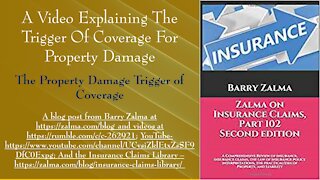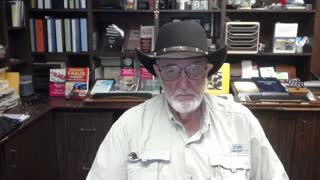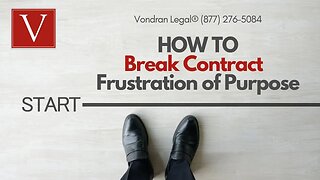A Video Explaining "Trigger" of Property Damage Coverage
The Trigger of Coverage/Property Damage
The term "trigger of coverage" means "what event must occur for potential coverage to commence under the terms of the insurance policy" and "what must take place within the policy's effective dates for the potential of coverage to be 'triggered.'" [In Re Feature Realty Litig., 468 F. Supp.2d 1287, 1295, n.2 (E.D. Wash. 2006)]
After the California Supreme Court adopted a continuous trigger in Montrose Chemical Corp. v. Admiral Ins. Co. (1995) 10 Cal.4th 645, 685, 42 Cal.Rptr.2d 324, 913 P.2d 878 (Montrose) in the case of successive policies, property damage that is continuous or progressively deteriorating throughout several policy periods is potentially covered by all policies in effect during those periods, so that the insurer’s duty to defend arose under those policies. Insurers, trying to limit their coverage, revised the policy wording.
Therefore, the precise question is what result follows under the language of the policies of insurance to which the parties agreed. The “continuous injury” trigger has been applied mostly in cases involving gradual release of pollutants and other environmental harms. After Montrose, the insurer revised its policies to use the language for the very purpose of "obviat[ing] the application of the ‘progressive damage-continuous trigger’ articulated in Montrose." As a result, the defendant’s policies state that property damage "which commenced prior to the effective date of this insurance will be deemed to have happened in its entirety prior to, and not during, the term of this insurance." [Ins. Co. of Pa. v. Am. Safety Indem. Co., 32 Cal.App.5th 898, 244 Cal.Rptr.3d 310 (Cal. App., 2019)]
The Louisiana Court of Appeals ruled that allegations by a property owner that an environmental consultant failed to detect the presence of pollutants on its property did not trigger coverage under the consultant’s liability policies. The Court found that the “occurrence” giving rise to the claims against the insured took place years prior to the issuance of the policies in question. Reaching a decision that comports with that of a majority of the states the Louisiana court said:
In order for there to be coverage under these policies, the property damage must have occurred during the policy period. The property damage was the contamination (physical injury) to the property, which was caused by previous owners and users of the site. GTL’s liability is hinged upon its failure to detect the contamination. Even if the property is not considered physically injured, property damage as defined by the policy includes “[l]oss of use of tangible property that is not physically injured.” However, that loss of use is deemed to occur at the time of the occurrence that caused it. That occurrence predated the policy by almost seven years. Accordingly, the property damage did not occur during the policy period, and coverage is unambiguously excluded. (Emphasis added.)
Whenever a claim is made for damage to property it is essential that both the insurer and the party making the claim determine the date and time when the property was actually physically damaged. Claims should then be made only to the insurer on the risk (the one whose policy is in force) at the time the physical damage occurred not the one whose policy is in force at the time suit is filed.
“While the term ’trigger of coverage’ is not a term used in an insurance policy, it is, as the California Supreme Court said, a convenience used to describe that which, under the specific terms of an insurance policy, must happen in the policy period in order for the potential of coverage to arise. The issue is largely one of timing — what must take place within the policy's effective dates for the potential of coverage to be 'triggered'?” [State v. Continental, 55 Cal. 4th 186, 281 P.3d 1000 (2012) (quoting Montrose Chemical Corp. v. Admiral Ins. Co., 10 Cal. 4th 645, 655 n.2 (1995).] Because occurrence policies (as distinguished from claims-made policies) cover occurrences that result in injury 'during the policy period,' the courts in California and elsewhere have concluded that the policies are invoked, or 'triggered,' when the injury takes place." [Armstrong World Indus., Inc. v. Aetna Cas. & Sur. Co., 45 Cal. App. 4th 1, 52 Cal. Rptr. 2.d 690 (1996) (collecting cases); Pennsylvania Gen. Ins. Co. v. Am. Safety Indem. Co., 185 Cal. App. 4th 1515, 111 Cal. Rptr. 3d. 403 (2010)). (“time of occurrence,” for triggering purposes, “is the time the complaining party was damaged, not the time the wrongful act was committed”) (internal quotation omitted).]
The word “trigger”, as a term of art, means the event that activates coverage under one or more insurance policies. The trigger of coverage problem arises in determining exactly what must take place within the policy’s effective dates to trigger coverage.
Different states apply different triggers of coverage theories, including:
the manifestation trigger;
the exposure trigger;
the continuous trigger; and
the injury-in-fact trigger (recognizing the existence of various trigger of coverage theories).
No Texas state appellate court has discussed which trigger of coverage theories should apply to a first-party claim under a standard homeowner’s insurance policy based on continuing or progressively deteriorating damage to the insured’s dwelling.
When the Travelers issued a policy that provides coverage for "injury or damage that . . . happens while this agreement is in effect" it limited its coverage to that temporal requirement that applies only to the injury that occurs while the policy is in effect. Travelers bargained for an injury-based trigger of coverage, not an act-based trigger. Under the policy's plain terms, Travelers must defend any claim in which covered injuries occurred between 2005 and 2011, regardless of when the wrongful causal act occurred.
ZALMA OPINION
Every claims person must be aware of the the trigger of coverage so that he or she can thoroughly investigate a property claim. Without knowledge of the various triggers of coverage and how the trigger applies to the fact of the loss being investigated the claims person will fail in his or her obligation to thoroughly investigate a claim and treat the insured fairly and in good faith.
© 2021 – Barry Zalma Barry Zalma, Esq., CFE, now limits his practice to service as an insurance consultant specializing in insurance coverage, insurance claims handling, insurance bad faith and insurance fraud almost equally for insurers and policyholders.
He also serves as an arbitrator or mediator for insurance related disputes. He practiced law in California for more than 44 years as an insurance coverage and claims handling lawyer and more than 54 years in the insurance business.
He is available at http://www.zalma.com and zalma@zalma.com. Mr. Zalma is the first recipient of the first annual Claims Magazine/ACE Legend Award. Over the last 53 years Barry Zalma has dedicated his life to insurance, insurance claims and the need to defeat insurance fraud. He has created the following library of books and other materials to make it possible for insurers and their claims staff to become insurance claims professionals.
Go to the podcast Zalma On Insurance at https://anchor.fm/barry-zalma; Follow Mr. Zalma on Twitter at https://twitter.com/bzalma; Go to Barry Zalma videos at Rumble.com at https://rumble.com/c/c-262921; Go to Barry Zalma on YouTube- https://www.youtube.com/channel/UCysiZklEtxZsSF9DfC0Expg; Go to the Insurance Claims Library – https://zalma.com/blog/insurance-claims-library/ Rhe last two issues of ZIFL are available at https://zalma.com/zalmas-insurance-fraud-letter-2/ podcast now available at https://podcasts.apple.com/us/podcast/zalma-on-insurance/id1509583809?uo=4
-
 13:21
13:21
Barry Zalma, Inc. on Insurance Law
3 years agoA Video Explaining the Trigger of Coverage for Property Damage
134 -
 10:46
10:46
Barry Zalma, Inc. on Insurance Law
3 years agoTrigger of Coverage/Property Damage
36 -
 3:40
3:40
Marketing, Real Estate and Fun
9 months agoAudio Blog: Title Insurance: Protecting Your Homeownership Investment
7 -
 1:05
1:05
SWNS
1 year ago2 in 3 homeowners do not know what their home insurance covers
17 -
 4:54
4:54
The Last Capitalist in Chicago
10 months agoDo I need title insurance?
65 -
 13:02
13:02
Attorney Steve® Legal News
4 years agoBreak lease with "Frustration of Purpose?"
34 -
 3:23
3:23
thelovelylawfirm
8 months agoFAQ How does Injury to Personal Property Work
27 -
 0:57
0:57
The Last Capitalist in Chicago
10 months agoWhat happens if you get sued for more than your policy limit?
28 -
 1:06:08
1:06:08
N8WUNZ
4 months agoEp 104 N8 Fri 19th Jan 2024 C19 IS NOT a Workplace Hazard & ACC the door to vax injrd claims
3917 -
 12:38
12:38
The Badwolf
1 year agoWhat is a CASH VALUE INSURANCE POLICY: Tips of the Wealthy, non taxable, private, loan value and...
54